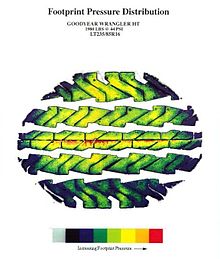- Contact patch
-
Contact patch is the portion of a vehicle's tire that is in actual contact with the road surface. It is most commonly used in the discussion of pneumatic tires, (i.e. pressurized tires), where the term is strictly used to describe the portion of the tire’s tread that touches the road surface. The term “footprint” is used almost synonymously.
The following discussion only applies to pneumatic tires.
Contents
Contact patch size
The contact patch is the only connection between the road and the vehicle. The size and shape of the contact patch as well as the pressure distribution within the contact patch are important to the ride qualities and handling characteristics of a vehicle. Since the wear characteristics of tires is a highly competitive area between tire manufacturers, a lot of the research done concerning the contact patch is considered highly proprietary and, therefore, very little is published on the subject.
Because pneumatic tires are flexible, the contact patch is different when the vehicle is in motion from when it is static. Because it is so much easier to make observations of the contact patch without the tire in motion, it is more common to conduct studies of the static contact patch.
Statically, the size, shape, and pressure distribution are functions of many things,[1] the most important of which are the load on the tire and the inflation pressure:
- The larger the load on the tire, the larger the contact patch.
- The larger the inflation pressure, the smaller the contact patch.
Unfortunately, these two properties are not linearly proportional to the area of the contact. Put another way, a 10% change in load or inflation pressure usually does not result in a 10% change in the contact patch.[2] This makes intuitive sense, because while you can alter the load or pressure freely, the contact patch size will always be limited by the tire geometry.
See also
- Camber thrust
- Cornering force
- Frictional contact mechanics
- Ground pressure
- Pneumatic trail
- Slip (vehicle dynamics)
References
- ^ Summary Report: Evaluation of Tire Size and inflation Pressure on Tire Contact Stress and Pavement Response by Emmanuel Fernando, August 2006.
- ^ Summary: Inflation Pressure Retention Effects on Tire Rolling Resistance, Vehicle Fuel Economy and CO2 Emissions presented to the California Air Resources Board July 4, 2008 by Walter Waddell
External links
Categories:- Tires
- Motorcycle dynamics
Wikimedia Foundation. 2010.

